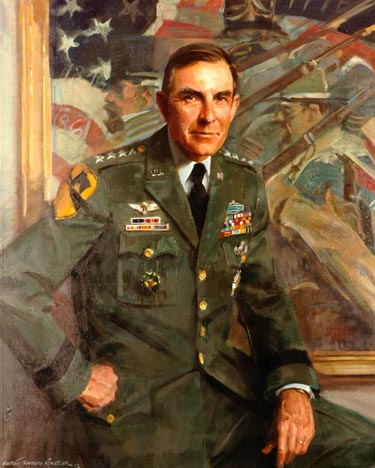
Edward Charles Meyer was born in St. Marys, Pennsylvania, on 11 December 1928; graduated from the United States Military Academy, 1951; was commissioned a second lieutenant and attended the Infantry School at Fort Benning, 1951; was a platoon leader, Company C, 25th Armored Infantry Battalion, in Korean operations, 19511952; was promoted to first lieutenant, July 1952; was a platoon leader, company commander, and battalion staff officer, 224th Infantry, in Korean operations, 19521953; served in the 1st Officer Candidate Regiment, Infantry School, 19531954; married Carol McCunliffe, 1954; was aide to the assistant commandant, Infantry School, 1954, and instructor in operations there, 19541957; was promoted to temporary captain, July 1956; graduated from the infantry officers advanced and basic airborne courses, 1957; was commander of Headquarters and Headquarters Company, 1st Airborne Battle Group, 501st Infantry, 19571958, and commander of Company D, 19581959; graduated from the Command and General Staff College at Fort Leavenworth, 1960; was promoted to permanent captain, February 1958, and to temporary major, October 1960; was manpower control officer, Office of the Assistant Chief of Staff, G1, United States Army, Europe (Rear), 19601961; was assistant executive and aide to the chief of staff at Supreme Headquarters, Allied Powers Europe, 19611963; graduated from the Armed Forces Staff College, 1964; was promoted to temporary lieutenant colonel, May 1964, and permanent major, June 1965; served in the Coordination Division of the Office of the Chief of Staff, 19641965; was deputy commander of the 3d Brigade, 1st Cavalry Division (Airmobile), in Vietnam operations, 1965; was commander of the 2d Battalion, 5th Cavalry, in Vietnam operations, 19651966; graduated from the National War College, 1967; served in the Plans and Operations Division, Office of the Joint Chiefs of Staff, 19671969; was promoted to temporary colonel, November 1968; was commander of the 2d Brigade, 1st Cavalry Division (Airmobile), and division chief of staff in Vietnam operations, 19691970; was a federal executive fellow at the Brookings Institution, 19701971; was promoted to temporary brigadier general, August 1971, and permanent lieutenant colonel, June 1972; was assistant division commander (support) of the 82d Airborne Division, 19711972; was deputy commandant of the Army War College, 19721973; was deputy chief of staff for operations, United States Army, Europe, and Seventh Army, 19731974; was promoted to temporary major general, August 1973; was commanding general of the 3d Infantry Division, United States Army, Europe, 19741975; was assistant deputy chief and deputy chief of staff for operations and plans, United States Army, 19751979; was promoted to permanent colonel, March 1976, and temporary lieutenant general, October 1976, and general, June 1979; was chief of staff of the United States Army, 22 June 197921 June 1983; prosecuted an Army-wide modernization program with emphasis on quality over quantity, stressed the need for a long-term investment in land force materiel, and launched a unit-manning system to reduce personnel turbulence and to enhance readiness; retired from active service, June 1983.
The Artist
Everett Raymond Kinstler (1926) began his art career drawing comic strips while still in his teens. A protégé of James Montgomery Flagg, he studied under Frank Vincent DuMond and Sidney Dickinson at New York Citys Art Students League, where he would later teach. In 1955 he made the transition from illustrator to portraitist, to become one of the foremost in his field. An academician of the National Academy of Design, Mr. Kinstler is a member of a number of art societies and the recipient of several awards. He is the author of Painting Portraits (1971) and has illustrated several books. Kinstler maintains a studio in New York City.
Edward Charles Meyer
By Everett Raymond Kinstler
Oil on canvas, 50" x 40", 1984
[150]

[151]